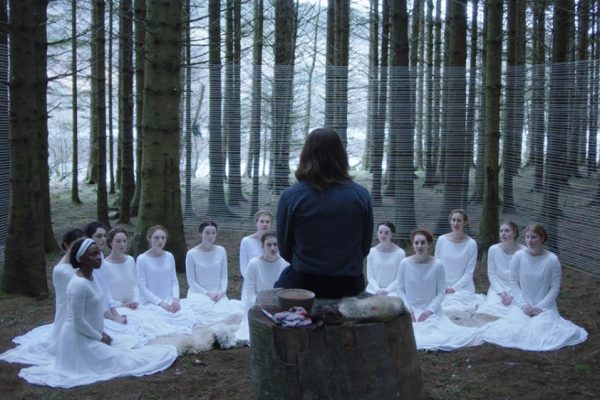Polish director Malgorzata Szumowska’s English language debut may be a victim of bad timing, given that many of the themes and imagery it contains are hugely redolent of the TV adaptation of The Handmaid’s Tale. This tale of a young woman coming of age in the confines of a religious cult is visually arresting throughout, and the simple story is poetically told. However, with the narrative largely explored through a litany of excessively blunt symbolism, it obfuscates rather than clarifies and erodes the dramatic impact.
Selah (Raffey Cassidy) has been a member of ‘the Flock’ since birth, the first to have been born into the cult. It’s headed, and dominated, by the Shepherd (Michiel Huisman) the sole male who runs the cult in a fashion similar to the Amish. There is no modern technology and the Flock are entirely self-sufficient. The women are wear modest woollen dresses, dyed red for the ‘wives’, and blue for the ‘daughters’. As she ages into the normal transition period for becoming a wife, Selah’s unshakeable faith in her prophet begins to waver, and then she discovers the truth about her late mother, the Shepherd’s favourite.
Cassidy and Huisman are compelling adversaries, playing a twisted game of attraction and repulsion. Huisman is handsome and charismatic enough that the hold he has over his flock is believable, but also exhibits that glimmer of insecurity that helps Selah’s doubts bloom. Cassidy (The Killing of a Sacred Deer, Vox Lux) for her part strengthens her indie darling credentials, handling the disturbing psychosexual elements with impressive skill.
None of the other women are given anything beyond token characterisation, beyond Denise Gough as a ‘wife’ side-lined as an outcast (presumably for disobedience given the livid scars her body bears). She bonds with Selah after the younger woman is made to sleep away from the group after beginning her period (this nod to the Book of Leviticus part of the biblical grab bag the Shepherd utilises). While the parallel between menstruation and the attainment of womanhood and self-awareness is a cliché, it helps Szumowska wrestle the focus of this sex cult tale away from the masculine virility of its leader and towards the emancipation of the flock.
As in her earlier films, Szumowska plays with the context of the female form, and the way it wields power. In Elles, the bodies of Anaïs Demoustier and Joanna Kulig are utilised by those women as transactional; in Mug, the naked figure of Malgorzata Gorol is cast as the unobtainable dream woman to the maimed hero, and in The Other Lamb, Gough’s skyclad nudity is coded as that of a dark goddess figure like that of Lilith, associated with the left-hand path. Its in the elliptical depiction of female empowerment that The Other Lamb excels.
Where The Other Lamb is less successful is in finding a satisfying resolution. While Szumowska’s dedication to showing, not telling is admirably rigorous it also resists deserved catharsis for Selah. Instead there’s too much recourse to obvious visual metaphor (Shepherd is at his most powerful in a heavily wooded area, at his most vulnerable he’s leading the reluctant Flock through a deforested wilderness, tree stumps galore), and one too many shots of Selah in a stare-off against the loan ram of the Flock’s actual flock. However, for all its blunt force poetic sense it’s a consistently beautiful, engrossing film that could play as a more obtuse companion piece and thematic prequel to Sean Durkin‘s Martha Marcy May Marlene.
As part of Glasgow Film Festival 2020
